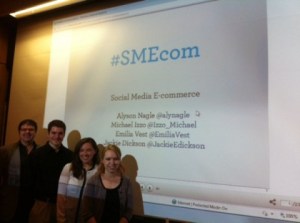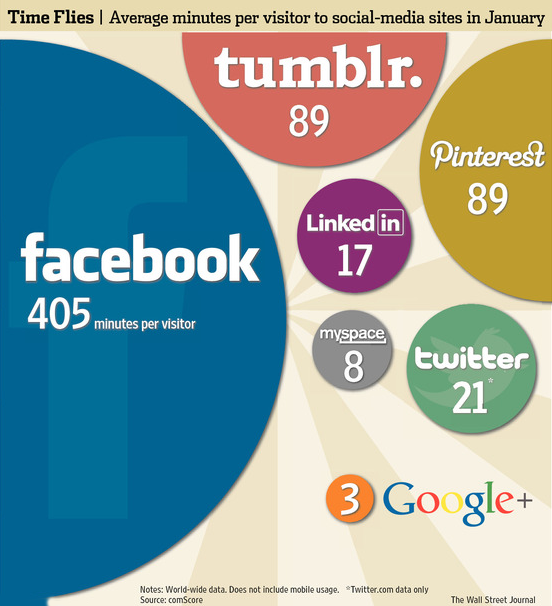For the past three months, I have been working on a team teaching project called “Social Media E-Commerce,” or #SMECom. The project has fascinated me, as I learned about the Want button, Tango Card, and F-Commerce. To learn more about each of these three points, I encourage you to check out my group’s Slideshare presentation on #SMECom:
Category Archives: Social Media
Trying Out Pearltrees
In my social media class, we received a visit from Oliver Starr, Chief Evangelist for Pearltrees. Pearltrees is a unique social networking site that allows you to turn bookmarking into an interactive and connective activity.
Here is my NewhouseSM4 pearltree (my class pearltree):
Vodpod videos no longer available.Each bookmark becomes a pearl that is movable and organizable in any way you like. Today, we made a pearltree for The Hunger Games and watched pearling happen in real time. Doing so allowed us to view the potential for this new and interactive tool. Instead of bookmarking to keep track of sites you need to remember, pearling allows you to sort through and organize your content, as well as the content of those with similar interests.
If you try out Pearltrees, definitely try out the search feature. It allows you to see related content to your search that has been curated by other people. Pearltrees also allows you to work on teams to curate content. I am currently working with my Social Commerce group to curate content on e-commerce. Pearltrees is a great tool for groups looking to research quickly and effectively.
Pearl responsibly!
JD
WANT to Keep up with Trends
A part of being savvy on social media is keeping your eyes open for the up and coming ideas. These ideas, like Google+, might not be that successful. However, staying on top of these trends helps you look more professional and also helps you have a valued opinion as to what is hot and what is not in social media.
This is where this:  comes in. The WANT button. All Facebook recently ran an article on the use of the WANT button gaining speed. Companies such as Sharper Image have already picked it up. This button acts the same as a Facebook, Twitter or other social media icon and is even more similar to a LIKE button. It tracks how many users clicked “want” and then posts this click on the user’s Facebook timeline. The use of this button helps companies track potential markets by alerting them to what online users picked their products and what else these users could be interested in purchasing.
comes in. The WANT button. All Facebook recently ran an article on the use of the WANT button gaining speed. Companies such as Sharper Image have already picked it up. This button acts the same as a Facebook, Twitter or other social media icon and is even more similar to a LIKE button. It tracks how many users clicked “want” and then posts this click on the user’s Facebook timeline. The use of this button helps companies track potential markets by alerting them to what online users picked their products and what else these users could be interested in purchasing.
Similarly, this:  has been popping up everywhere. With Pinterest growing at 4000 percent over six months, I was not surprised to see the PIN IT button pop up on commerce websites. It shows that businesses are using the popularity of Pinterest to their advantage, offering yet another example of not getting left behind in the social media game.
has been popping up everywhere. With Pinterest growing at 4000 percent over six months, I was not surprised to see the PIN IT button pop up on commerce websites. It shows that businesses are using the popularity of Pinterest to their advantage, offering yet another example of not getting left behind in the social media game.
These buttons may not seem earth-shattering. However, they are the perfect examples of social media filtering into daily life in new and unexpected ways.
WANT responsibly!
JD
Apple Factory Issues: Reaction
The Apple factory conditions should not be news to those of us in the social sphere. Twitter trending, blog posts and Facebook comments have alerted a lot of the public to the conditions for workers at Apple’s overseas plants. This infographic, courtesy of OnlineMBAPrograms.org helps illuminate the realities that these workers face.
With a crisis such as this surfacing, it is important to take a minute to discuss possible outcomes. When I took the issue to my PR management class, everyone was skeptical that Apple sales would change as a result of this news. The overseas nature of this crisis allows consumers to feel that disconnect between a company and its workers.
Another issue that has arisen is the petitioning. This specific petition highlights the desire for Mac users to feel proud that they own Mac products. As a Mac user myself, I now feel guilt every time I pick up my computer or phone. However, is that enough to make me stop using it?

The sad truth is that my answer is no. I will continue to use my Macbook and iPhone simply because they work better than anything else on the market (at least in my opinion). That is the kicker on this issue for Apple sales vs. worker ethics. When you have quality to boast about, along with a large market share, how else can the public react?
Think responsibly!
JD
Musically Social: Collaboration in the Social-Music World
This week, I have seen two examples of social media helping out music. As a music major and all around lover of the musical world, I was really excited to see both posts. The first, from Mashable, details VH1 working with Foursquare for VH1’s Save the Music Foundation. This social event allows Foursquare users who follow VH1 to get a limited edition VH1 Save the Music badge when they check in at a US music venue. Then, VH1 will donate up to 35,000 dollars to the foundation for every badge awarded.
The other music-social team up, reported on here by Social Times, describes ‘Virtual Choir,’ a Youtube experience that brings singers from 73 countries together performing one piece. The project, run by Grammy Award-winning composer Eric Whitacre, allows singers to record themselves singing along to a prerecorded piece of music. Then, all submissions are edited together to create one video of a virtual choir. This year, there were 3,746 submissions, which were edited into a video that premieres in April in New York City. (You can check here for more information.)
Both projects are extremely different, yet both demonstrate how social has the power to help a common cause (in this case music) and in the case of Virtual Choir, actually create music. Though social is often times a content sharing device, it can also easily act as a campaign platform for a good cause. Since social media has such a far-reaching scope and is so easily accessible, it lends itself to projects such as Virtual Choir and VH1 Save the Music.
How Social Doesn’t Always Succeed While Trying
A new report shows Google+ (G+) is quickly declining in “usership.” An article on Social Media Today shows that G+ users are averaging only 3 minutes per month on G+ whereas Facebook users spend between six and seven hours a month of Facebook. I can’t say I ever expected G+ to replace Facebook and I also don’t think Google thought that either.
G+ is instead a content-driven platform that encourages open dialogue and sharing. I have found it more useful as a news and conversation tool with social media pros, blogs and companies than as a social tool. Although G+ clearly has social features built in, such as “hang out” and the friends circle, there is much more that aids it as a content tool. The aesthetically pleasing interface, company pages, and 1+’s all lend themselves well to content sharing. You can also easily select what audience you want to share your content with at the click of a button.
Another new content sharing site, Pinterest, is seeing far more usership. According to the same Social Media Today post, Pinterest users spend 89 minutes per month on the site, compared to the 3 minutes seen with G+ users. This Hubspot post is a great insight into Pinterest, which grew 4000% in the past six months. Pinterest has the social vibe, with the ability to like and comment on pins. It also has the content sharing ability of other social sites. However, it is seeing unprecedented success as a new social medium while G+, run through search engine powerhouse Google, is on the decline. Sometimes, social can be very unpredictable, which makes it both very scary and very exciting.
1+ and pin responsibly!
JD
Social Commerce via Facebook
A big trend right now is using Facebook to gain the attention of your business’s target markets. Just yesterday, my social media class spent thirty minutes examining Facebook targeting metrics for advertising. If you want to target women in their twenties in a certain area/market, Facebook will show you how many of this market you are likely to attract with your ad placement. Thinking back to the days when Facebook was simply a site where you posted on a wall or direct messaged someone, this is impressive!
This post comes in light of THIS POST from Web Pro News. In summary of Web Pro’s post, Universal Pictures is leveraging Facebook as a platform to drive ticket sales for a few of its movies. Universal is also using Friend2Friend, a social engagement app creator, to help drive ticket sales and create a movie going experience that is social (in the virtual sense of the word).
I’m personally very interested to see how this works for Universal. Other companies as of late have been trying to leverage Facebook to drive social commerce with little success. All Twitter just released this infographic, showing that social commerce has not picked up speed just yet. The infographic says that 55% of consumers don’t trust their credit card info on social sites.
Social commerce is definitely something to watch out for in 2012, though. The buzz behind the idea is evident. Now, we wait to see if it actually picks up.
Shop responsibly!
JD
Social Engagement Journey
My engagement with social media has been about finding where I see myself fitting in to the already booming online dimension of social. At first, I was wary of Twitter and I didn’t see the point of G+. Now, I am active on both and feel more confident as a current job seeker as a result. As a college student, harnessing the power of social, and using it to your advantage, shows that you are a budding professional. I don’t shy away from questions about social media and my involvement during job interviews.
In my own field, public relations, social media is firmly embedded into the daily rituals of the industry. Being knowledgeable about social media, in all of its forms, allows me to
1. have a conversation point and
2. be relevant.
It is surprising how many job seekers still don’t have a LinkedIn (you can find mine here) or a Twitter account (Follow me!). I think FEAR of social media, its real-time nature and public/privacy settings, turns a lot of people off to the powerful tools.
For all of you who still have Twitter fear, this post, though a bit dated, offers up the easiest advice on getting started on Twitter. The most important thing to remember, which has helped me immensely, is to dive into those conversations on topics relevant to your interests. Only then, when you have immersed yourself in Twitter, will you feel confident about your tweeting abilities.
Post often. Tweet responsibly!
JD




